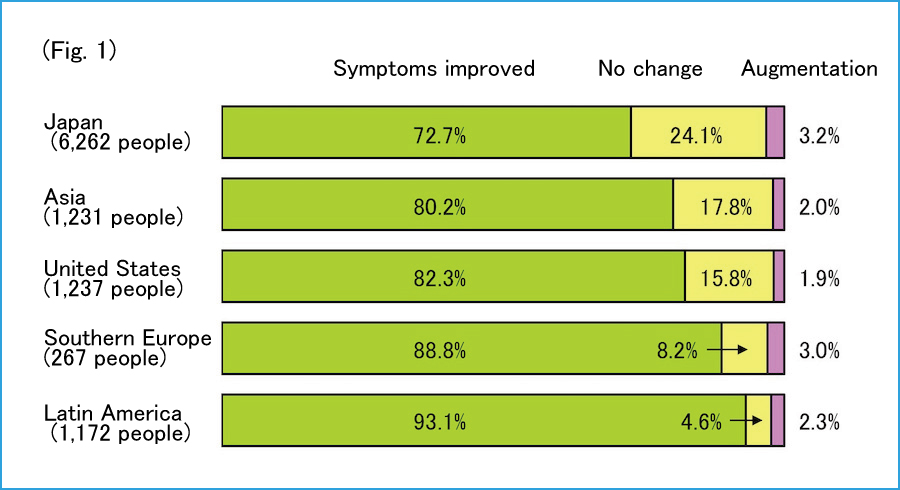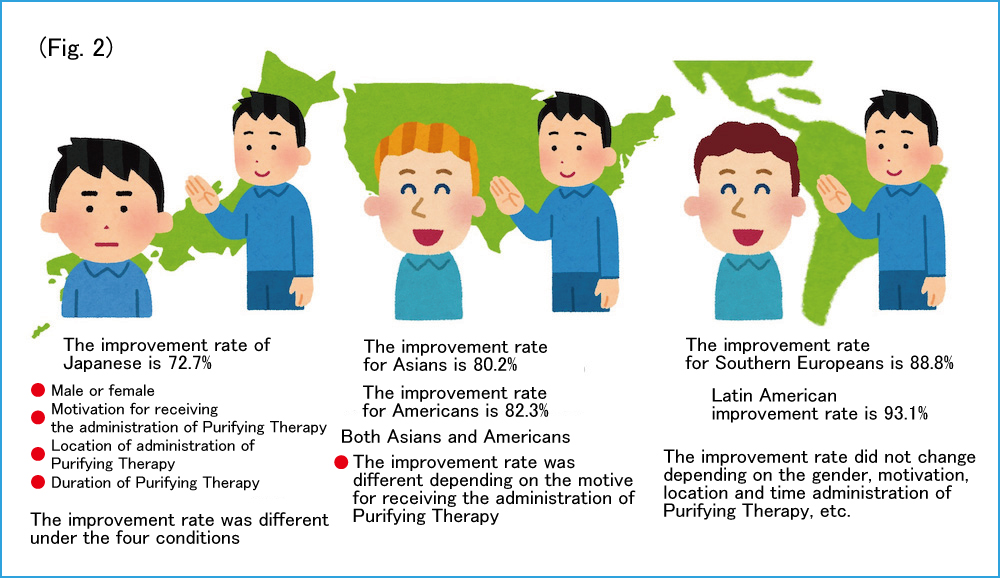Kiyoshi Suzuki, MD, PhD
President, MOA Health Science Foundation
I will continue to talk about the effects of Okada Purifying Therapy.
According to a large-scale domestic survey conducted in 2007, about 70% of Japanese people answered that their body pain, psychiatric symptoms, and autonomic nervous system symptoms improved after the administration of Purifying Therapy. The improvement rate differed depending on the four conditions: 1. Male or Female, 2. location of Purifying Therapy administration, 3. motivation for receiving Purifying Therapy, and 4. duration of administration of Purifying Therapy time (see last report). This is the result of analyzing the responses of more than 60,000 people, and it was almost the same as the preliminary survey (see the previous survey), so it is quite reliable.
In addition to Japan, the survey was conducted in 15 countries, including the United States, Asia (Thailand, Taiwan, South Korea), Latin America (Chile, Peru, Argentina, Mexico, Brazil), and Southern Europe (Spain, Portugal). Especially in the United States, Asia, and Latin America, we received responses from more than 1,000 people each, so the data is quite reliable. This result was published in the highest-ranked medical journal in the field of integrative medicine “Journal of Alternative and Complementary Medicine.” (2020; 26 (8): 708-720). The article was evaluated by experts from all over the world as a very interesting result. There is a Japanese report in the MOA Health Science Center Research Report Collection (2020; 24: 21-33), so please read it if you are interested.
1.Research purpose and research method
As I already mentioned, this study was designed to investigate 1. How much the symptoms improve with Purifying Therapy, 2. Are there conditions that make it easier for the symptoms to improve or increase?
Participants received the administration of Purifying Therapy for 30 minutes or more. Before and after the administration, 1. body pain, 2. irritability / anxiety / depression (psychiatric symptoms), 3. agitation / cold hands / feet / dizziness (autonomous neurological symptoms) were assessed using a 5-point scale. In addition, they also answered about changes in overall symptoms.
2. Result of investigation
 Figure 1 shows community changes in overall symptoms. Physical pain, psychiatric symptoms, and autonomic nervous symptoms all showed similar results since the improvement rate itself only differed by a few percent. What is interesting is that the improvement rate of Japanese people was about 70%, but it was more than 80% in Asia and the United States, and more than 90% in Latin America. I was just amazed that there was such a difference in the improvement rate.
Figure 1 shows community changes in overall symptoms. Physical pain, psychiatric symptoms, and autonomic nervous symptoms all showed similar results since the improvement rate itself only differed by a few percent. What is interesting is that the improvement rate of Japanese people was about 70%, but it was more than 80% in Asia and the United States, and more than 90% in Latin America. I was just amazed that there was such a difference in the improvement rate.
 Analyzing when the symptoms were likely to improve, as shown in Fig. 2, the improvement rate was higher among Asians and Americans who received the administration of Purifying Therapy in anticipation of the effect. However, Latin Americans had such high improvement rate but I could not find any special condition that brought such results. In this international survey, the condition that most affected the improvement rate was, after all, “community they lived in.” The motivation for receiving and the duration of the administration of Purifying Therapy also affected the improvement rate to some extent.
Analyzing when the symptoms were likely to improve, as shown in Fig. 2, the improvement rate was higher among Asians and Americans who received the administration of Purifying Therapy in anticipation of the effect. However, Latin Americans had such high improvement rate but I could not find any special condition that brought such results. In this international survey, the condition that most affected the improvement rate was, after all, “community they lived in.” The motivation for receiving and the duration of the administration of Purifying Therapy also affected the improvement rate to some extent.
So why was “community” so important? One of the reasons is the difference in the way of thinking about so-called “hand healing.” Latin Americans tend to have spiritual ways of viewing things. There is also a traditional “hand healing,” so it seems that Purifying Therapy was not too uncomfortable for them. In fact, 67% of people received Purifying Therapy with the expectation that it would be effective even though it was their first try. Latin Americans also tend to be sensitive to pain and may not have missed even the slightest change in symptoms.
According to another report, Latin women have a more spiritual mindset and are more sensitive to pain than Latin men, which may be the reason why women have a higher improvement rate than men, even in Japan. By the way, being sensitive to pain and “pain” are different. In my experience, I think men are more vulnerable to pain.
So far, I have shared about the effect and safety of one administration of Purifying Therapy. From the next time, I will share about the effect of continuing the administration of Purifying Therapy. Please look forward to it.
【Profile】
Kiyoshi Suzuki
Graduated from Tohoku University School of Medicine in 1981. Medical doctor. After working as a deputy director of the pediatric department at Sakakibara Memorial Hospital, working at Seijo Clinic, and as a director of the Gyokusenkai MOA Takanawa Clinic and Tokyo Clinic, he was the president of the MOA Health Science Foundation and the honorary director of the Tokyo Wellness Center. (Director of Japanese Association for Alternative, Complementary and Traditional Medicine and Chairman of the International Committee. In 1994, he was awarded the Young Investigator’s Award by the Japanese Society of Pediatric Cardiology.






